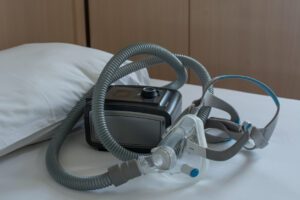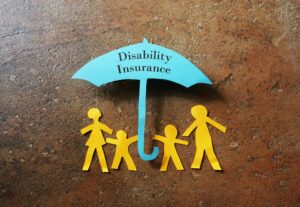
If you are a veteran diagnosed with sleep apnea, you may be eligible for VA disability benefits. You may also be one of thousands of servicemen and women frustrated with their service-connected sleep apnea claims and the VA benefits system. And it’s no wonder, as these claims are often denied by the VA.
Service connection can be tough to prove—especially when it’s been years since active duty. We want you to know that, with the right action and evidence, you can prevail.
First, remember that your claim for sleep apnea syndrome is just like any other VA disability claim. You must have or prove the following three things to win it:
- A diagnosis of sleep apnea involving a sleep study
- The sleep apnea started during or worsened as a result of, active duty service
- A nexus (connection) between your current diagnosis and the in-service event
Second, and just as for any other VA claim, you must connect the sleep apnea to your military service by one of two paths:
- Direct service connection, or
- Secondary service connection
What we emphasize is this: your sleep apnea claim must contain solid, relevant evidence that is developed and portrayed clearly and effectively to VA. You must produce the facts that will connect the dots for the VA that your disability is related to neurological or physical damage suffered during service.
This is what will compel VA to acknowledge service connection and rate your disability for sleep apnea fairly with the benefits you deserve.
The first way to service connect your disability is by direct service connection.
Call or text (800) 562-9830 or complete a Free Case Evaluation form
1) Direct Service Connection for Sleep Apnea
For direct service connection you must show either of the following:
- You were diagnosed with sleep apnea during your military service; –or–
- You must prove the onset of sleep apnea occurred while you were in service. In other words, during active service, you experienced symptoms that a doctor can say are evidence of sleep apnea.
a) If you were diagnosed with sleep apnea during military service:
This is the quickest path to gaining a service connection. It is also the rarest. In a war zone, sleep disorders are the last thing on a soldier’s mind; a veteran’s focus is on enemy fire and survival, not sleep studies. Many veterans are unaware they suffer from sleep apnea; all they know is, due to the rigors and demands of military service, they can’t sleep, they are exhausted, and are unable to stay awake or function at 100% during the day. Still others do not report their problems as to avoid a diagnosis that might adversely affect their military career.
If you do have an in-service diagnosis of sleep apnea, and now (at the time of your claim) you are disabled, you are likely well on your way to winning your claim.
So what do you do if you have sleep apnea but did not get an in-service diagnosis, or never reported it? Perhaps now, after 20 years have passed, you wish to file a disability claim for sleep apnea with VA. How do you connect your claim to your military service?
b) To prove the onset of sleep apnea occurred while you were in service, you need to bridge the gap from “then” to “now.”
Without an in-service diagnosis, now you must prove that you had symptoms during your time in service. This is the most common route of veterans’ claims for sleep apnea.
To show your disability began during service, you will need to:
- Have a current diagnosis of sleep apnea with a sleep study;
- Provide VA with competent and credible lay evidence of symptoms of sleep apnea that occurred during your time in service (and which continued thereafter); plus
- Obtain a credible medical opinion that ties the lay evidence to your current disability. This is your nexus statement.
What Is Sleep Apnea Lay Evidence?
Solid, reliable lay evidence consists of statements that establish the basis for the symptoms you experienced during service. Sleep apnea lay evidence will include written accounts of observed symptoms. These include in-service buddy statements from veterans who bunked near you, or your spouse who was with you during your active service, who saw you repeatedly stop breathing during sleep, heard you gasping for breath, snoring loudly through the nights, and watched you falling asleep or struggling to stay awake during the days.
Continuity of disability over the years can be supported through statements from your spouse, colleagues, friends, and relatives, observing your ongoing disability due to sleep apnea post-service.
Further lay evidence of record should also include any documented history of any form of sleep disturbances you may have had during service.
What is Sleep Apnea Medical Evidence?
Along with your diagnosis, you obtain medical evidence in the form of a written opinion, from a qualified physician who reviews your buddies’ or spouse’s statements and all other lay evidence. The medical review will be based on and supported by accredited medical research, studies, and facts relevant to your claim. The physician acknowledges that your in-service experiences were indeed symptoms and that your current sleep apnea is related to your time in service.
Your doctor’s statement, also called a nexus statement or nexus letter, bridges the gap and establishes the continuation of symptoms from your time of service, to your current diagnosis of sleep apnea, and now to your claim. Your claim should explain that you have never stopped having symptoms, and so your disability is connected to your service as a veteran (and not anything else.)
This, in turn, sets the stage for a finding that in fact, although you were not diagnosed during service, you as likely as not acquired the condition while you were in service or developed the condition as a result of your time in service.
With your current disability and the above efforts, you stand to gain VA’s grant of service connection.
For a free legal consultation, call (800) 562-9830
2) Secondary Service Connection for Sleep Apnea
This situation is when you did not have sleep apnea during service, but you began to experience the disorder after your discharge from service. You’re going to show that a service-connected condition that you have, such as asthma, PTSD, or facial injury, has caused your sleep apnea.
There is no difference in the weight of evidence needed to prove these claims. You will also need evidence of nexus between the first service-connected condition and the sleep apnea.
Prevailing in these claims requires a full understanding of the medical evidence that connects sleep apnea with other disabling physical and mental health conditions.
It is always a good decision to talk with a VA attorney or veteran’s advocate who understands the associations between your disabilities. You may also learn about additional claims for secondary service connection that you may not have otherwise considered.
Get Help with Your VA Sleep Apnea Claim Today
As accredited veterans’ attorneys, we are honored to discuss with you any problems or questions you may have about your sleep apnea disability claim or appeal. If you are not satisfied with VA’s handling of your claim for benefits, please call Marc Whitehead & Associates at 800-562-9830 for a free consultation without delay.
A Final Word:
In all cases, you will need to have a diagnosis of sleep apnea for compensation rating purposes. A diagnosis must be confirmed by a sleep study. Whether you suffer from obstructive, central, or complex (mixed) sleep apnea syndromes, ratings are based on the severity of the disability.
A VA rating of 50 percent requires the use of a CPAP machine or other approved breathing assistance device. Please be careful to not make the error of thinking that a prescription for CPAP apparatus with a current diagnosis of sleep apnea is going to get you a rating. You must always establish a service connection first.




